Gooey mochi dough filled with red bean paste and coated with crispy sesame seeds, Chinese sesame balls are simply delightful! Learn top tips to make them to perfection.
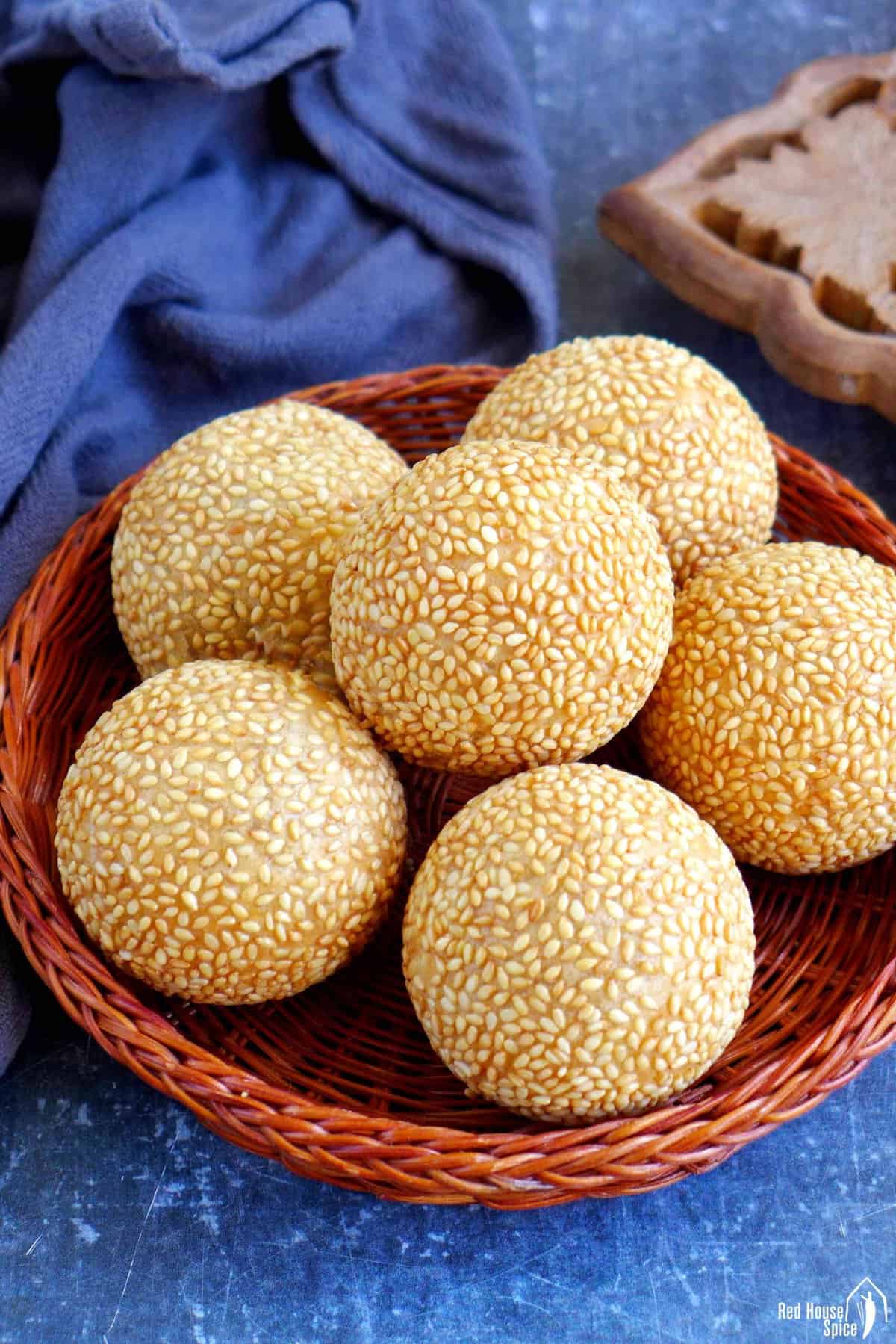
Jump to:
What are sesame balls
Sesame balls, a beloved Chinese sweet treat, are known by various names in Chinese, including Jiān Duī/煎堆, Zhī Má Qíu/芝麻球, Má Tuán/麻团, and more. A Vietnamese delicacy that shares very similar characteristics is called Bánh Cam or Bánh Ran.
Essentially, they’re deep-fried dough made from glutinous rice flour, filled with a sweet filling (though sometimes left unstuffed), and coated with white sesame seeds.
They are loved for their perfectly round shape, golden brown color, contrasting textures (crispy outside, chewy and creamy inside), and a sweet, aromatic, nutty taste.
You can find sesame balls at street stalls sold as breakfast or snacks in China as well as in dim sum restaurants. For many, they are also a must-have treat on Chinese New Year menus as they symbolize prosperity. This belief stems from the fact that their mochi-like dough expands magically, without the use of leavening agents, during the deep-frying process.
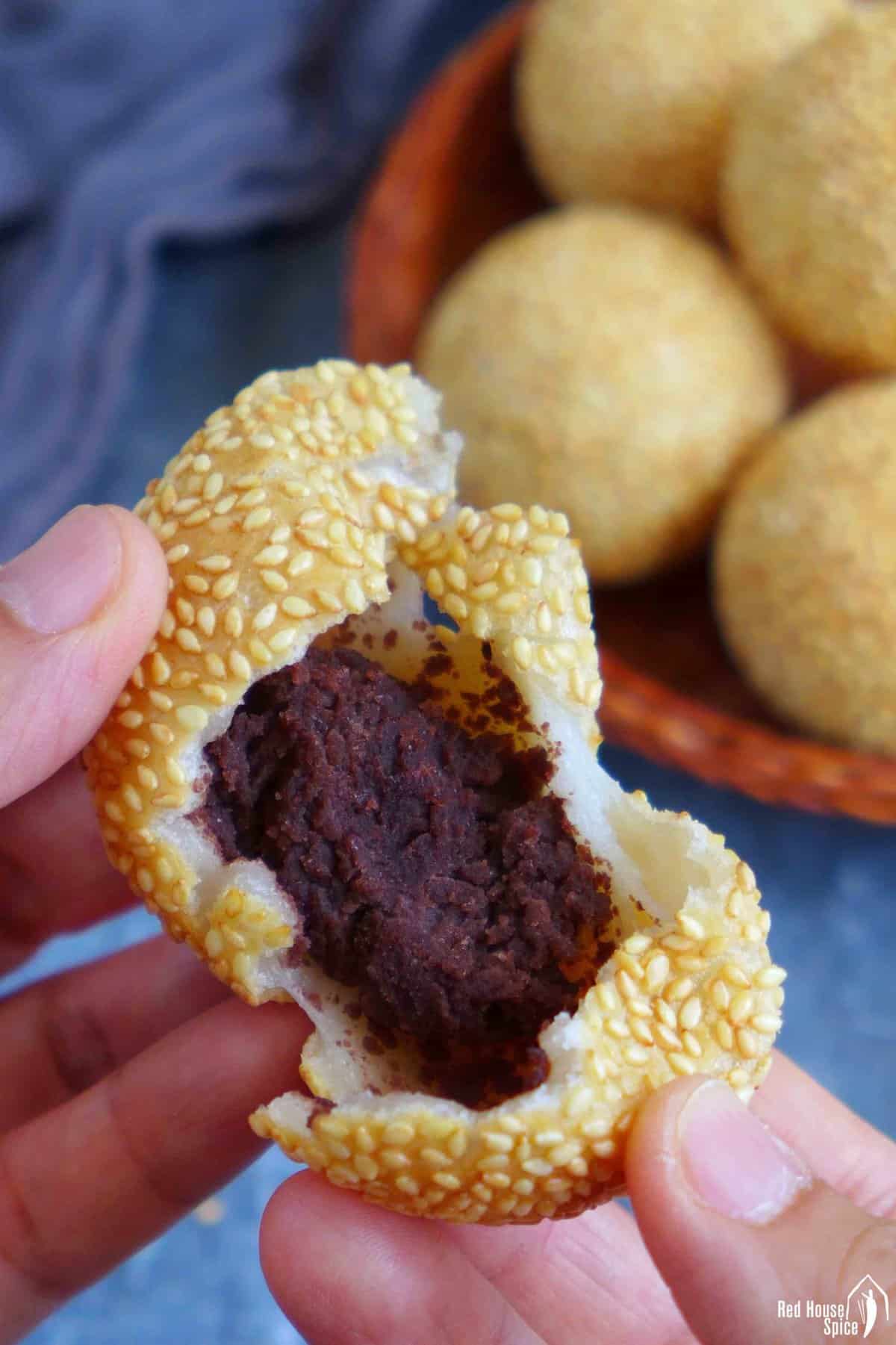
Top tips
🛎 Before you scroll down to the recipe details, I encourage you to read the following tips first. They help you cook sesame balls safely and successfully. So do not skip!
- You must follow the recipe precisely. Don’t attempt to wing it.
- You must use just boiled water to make the dough to achieve a stretchy consistency that’s crucial for expanding.
- Form balls of even size and seal the filling tightly leaving no weak point that might break during frying.
- Control the oil temperature properly, using a kitchen thermometer, to prevent the balls from bursting.
Ingredients for the dough
To make the dough for sesame balls, you’ll need the following ingredients:
- Glutinous rice flour
- White sugar
- Hot water (just boiled)
- Neutral-flavored cooking oil
Glutinous rice flour (Nuò Mǐ Fěn/糯米粉), also known as sweet rice flour, is finely ground glutinous rice that has the same color and texture as cornstarch. Despite the term “glutinous”, it’s completely free from gluten.
It plays a key role in many classic Chinese desserts, such as Glutinous Rice Balls, Snow Skin Mooncakes, Chinese New Year Cake, etc. You can find it in most Chinese/Asian stores.
🛎 NOTE: Wheat flour, regular rice flour, or starch CAN NOT be used as substitutes since none of them creates the sticky, gooey texture that sesame balls are cherished for.
Filling options

To stuff the sesame balls, you are free to choose your favorite fillings. The classic options include red bean paste (the one I used for shooting this recipe), black sesame paste (a popular filling for Tang Yuan), lotus seed paste (often found in Cantonese mooncakes), mung bean paste, peanut paste, etc.
If time permits, I encourage you to make your own fillings (click the links above for recipes). They have better taste, less sugar, and no additives/preservatives compared to the shop-bought versions.
Don’t have any filling? Don’t worry! The plain, unstuffed sesame balls are very tasty too. Learn how to adapt the recipe in the later section titled “Variations”.
🛎 TIP: The dough-to-filling ratio is about 2:1 in volume. That means the filling should be half the size of the dough. Overly stuffed sesame balls have thinner dough wrappers which have less strength to bear the expansion while deep-frying.
Prep & cook workflow
Step 1: Prepare the dough
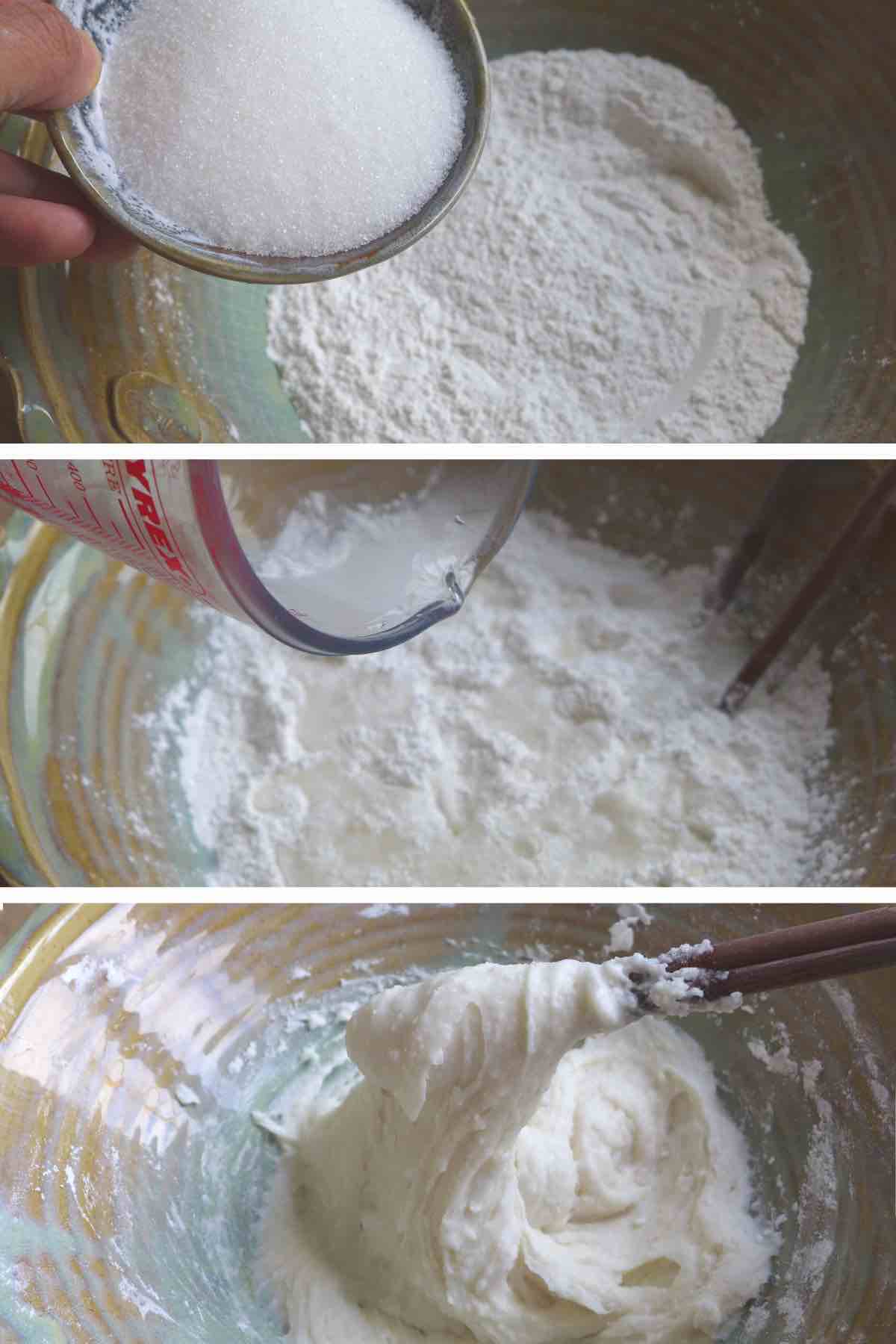
In a mixing bowl, add ⅔ of the glutinous rice flour that you need for the recipe. Add sugar and mix well. Then pour hot water (just boiled) over the mixture. Stir vigorously with chopsticks until it becomes a thick, sticky paste.
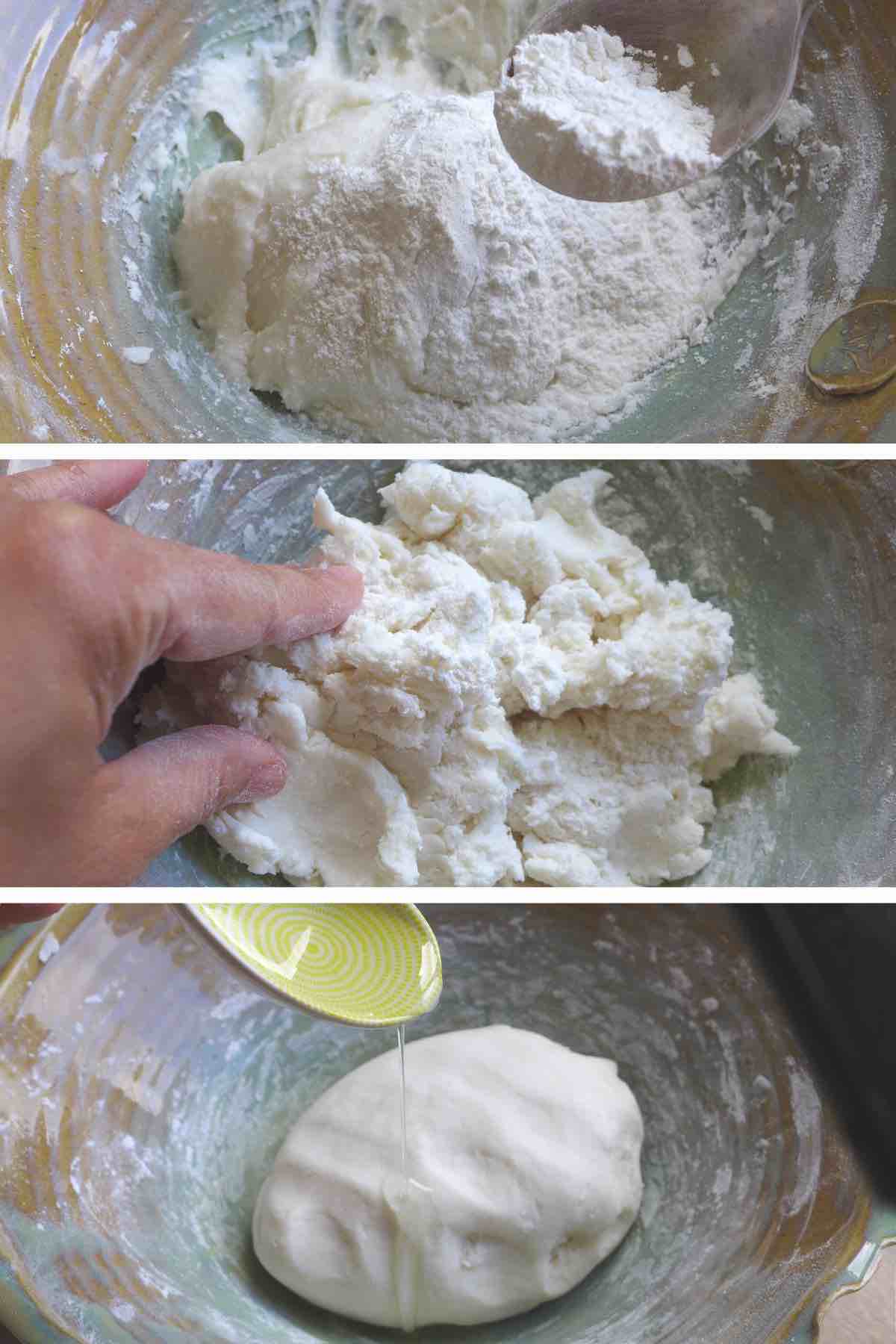
Add the remaining ⅓ of the flour. Stir it into the paste with chopsticks, then combine and knead with your hand until a cohesive dough forms. Finally, add a little oil and knead again to achieve a smooth dough.
The dough should be soft, and stretchy, but not sticky. Unlike dumpling dough which is made of wheat flour, glutinous rice flour-based dough is much more forgiving so it’s easy to adjust its texture. Rub in more flour if the dough appears sticky, or fold in a little water if it seems too dry.
🛎 TIPS:
- Make sure the water has just been boiled. Cold or warm water won’t give the dough the stretchability that it needs, therefore you’ll end up with a dough that crumbles easily.
- You don’t need to rest the dough. As long as it has been well kneaded to a smooth look, you can use it straight away.
- It’s fine to make the dough in advance. Wrap it tightly and store it in the fridge. Bring it back to room temperature before assembling and deep frying.
Step 2: Divide the dough & filling
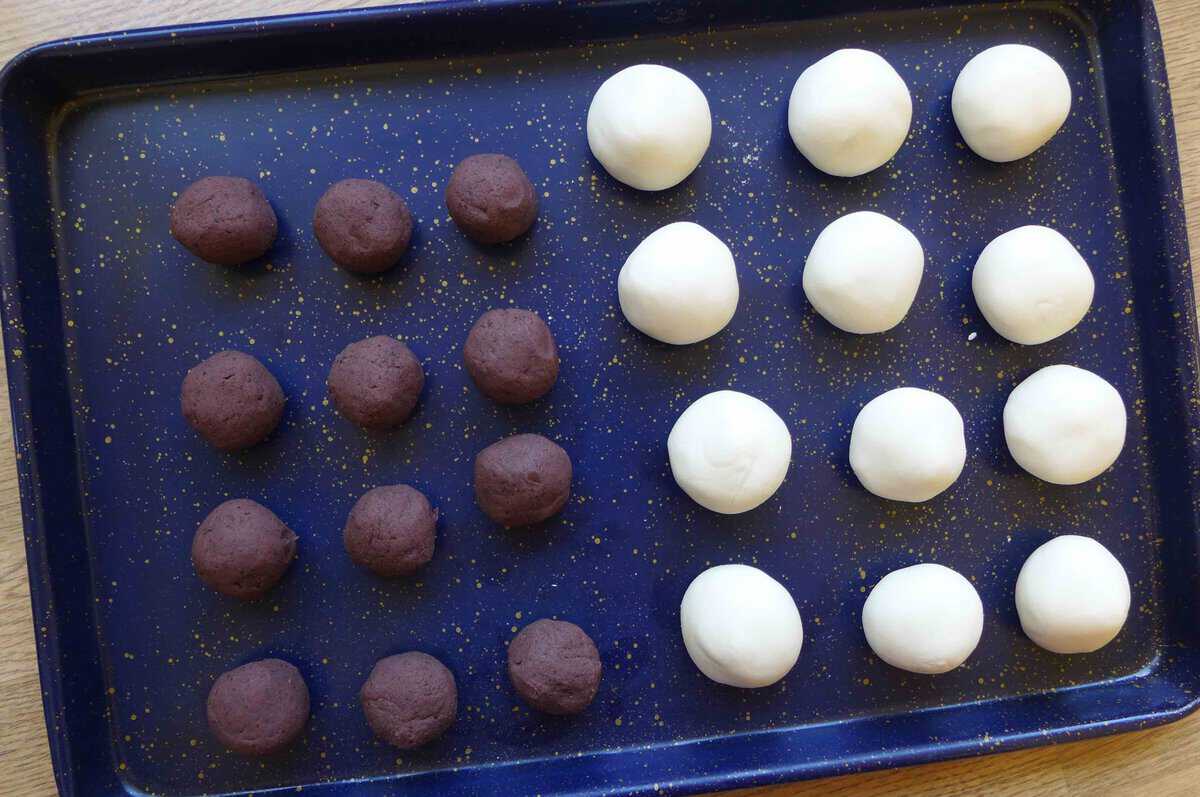
Divide the dough and the filling of your choice into equal pieces. Use a kitchen scale for precision. This helps to ensure all the sesame balls are of very similar size thus they can be cooked uniformly.
With the palms of your hands, roll all the dough pieces and the filling into balls. If your filling is on the soft side, refrigerate it or freeze it for a short while to make it firmer.
🛎 TIP: Cover the dough balls with a piece of cling film in case they lose moisture during the next step of assembly. This is particularly important if your kitchen is hot and dry, or there is a draught coming through.
Step 3: Assemble the balls
The method of shaping sesame balls is the same as how you wrap Glutinous Rice Balls. Here is the procedure:
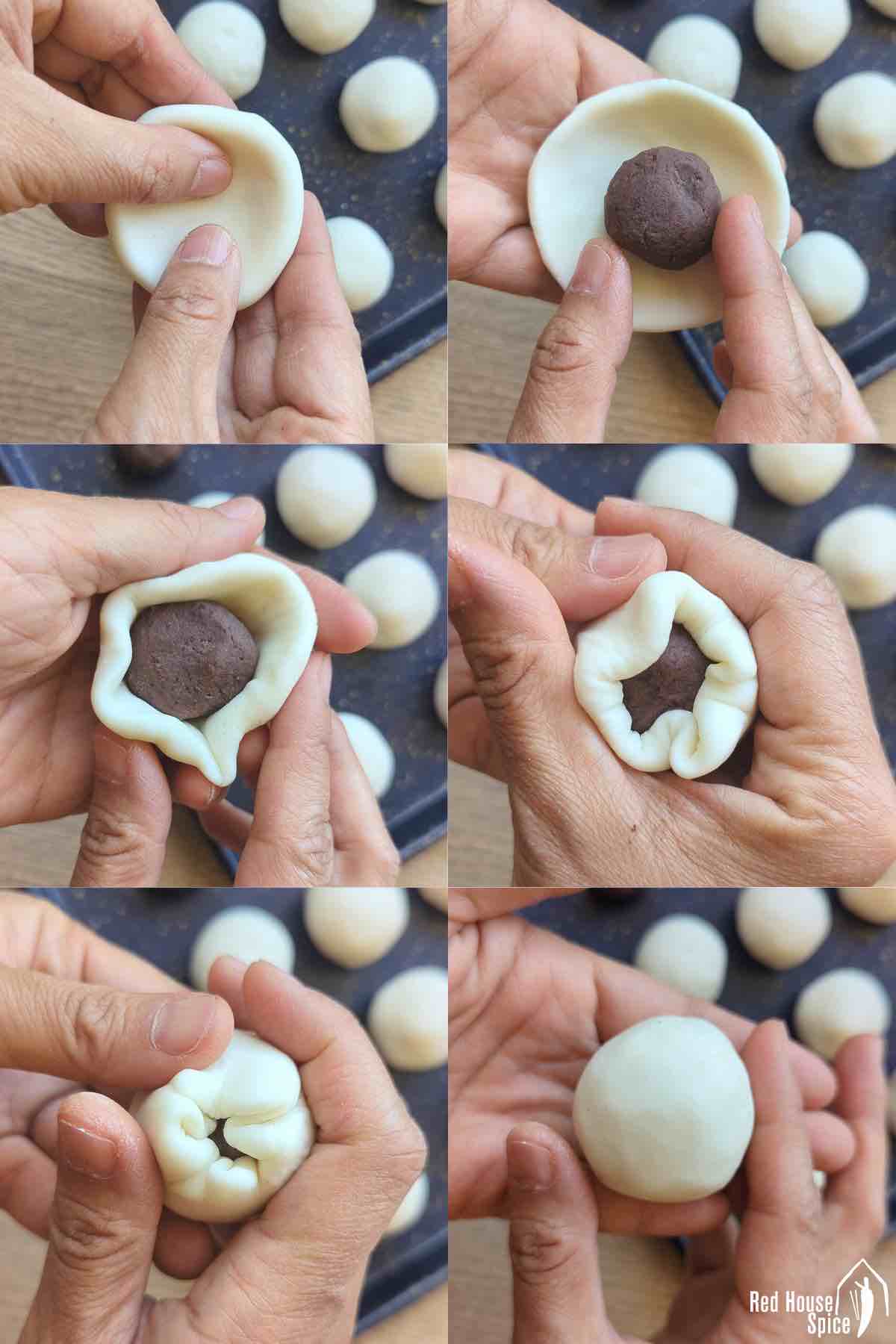
- Use your thumb to press the middle of a piece of dough, then pinch the rim to form a little bowl.
- Place a piece of filling inside the bowl. Gently push the edge of the dough upwards to wrap around the filling neatly and tightly.
- Seal the dough at the top, making sure there isn’t any leakage or weak point.
- Roll the assembled ball between your palms to achieve a roundish shape.
🛎 TIPS:
- Take your time to shape each sesame ball with great attention to detail. Ideally, the dough should have a rather even thickness all around the filling. This helps to prevent leakage or bursting during the deep-frying process.
- If you spot any particularly thin area, patch it up with a little dough using a dab of water to stick. Then gently smooth any joint.
Step 4: Coat with sesame seeds
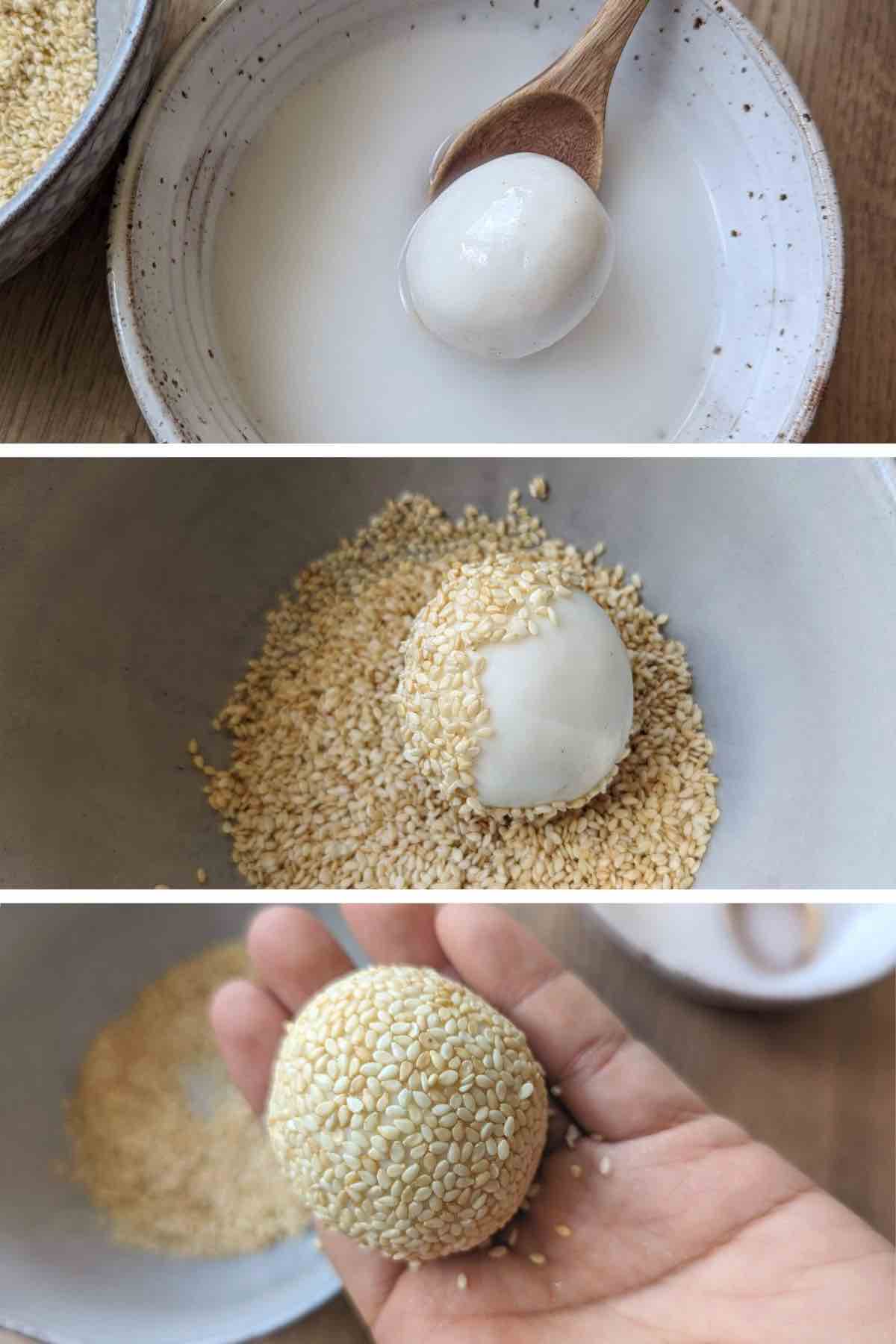
Prepare two bowls for this step. Fill one with water mixed with a spoonful of glutinous rice flour and the other with sesame seeds (raw or lightly toasted).
Quickly dip one assembled ball in the water to wet it all around. Then use a spoon to transfer it to the sesame bowl.
Hold the bowl with both of your hands and shake it in a circular motion. This allows the ball to roll around and have itself entirely covered by the seeds.
Between your palms, roll and gently press the coated ball so that few seeds will fall off during deep frying.
Step 5: Deep fry the balls
Pour cooking oil into cookware of your choice for deep frying. It should be enough to submerge the sesame balls. I use a saucepan and fry the sesame balls in two batches. This way I don’t need to use too much oil.
The deep-frying process includes two stages:
Stage 1: Cook the dough at low temperature
Heat the oil over medium-low heat until it reaches 250°F/120°C. Gently slide in the balls one by one. Do not overcrowd so there is room for them to expand.
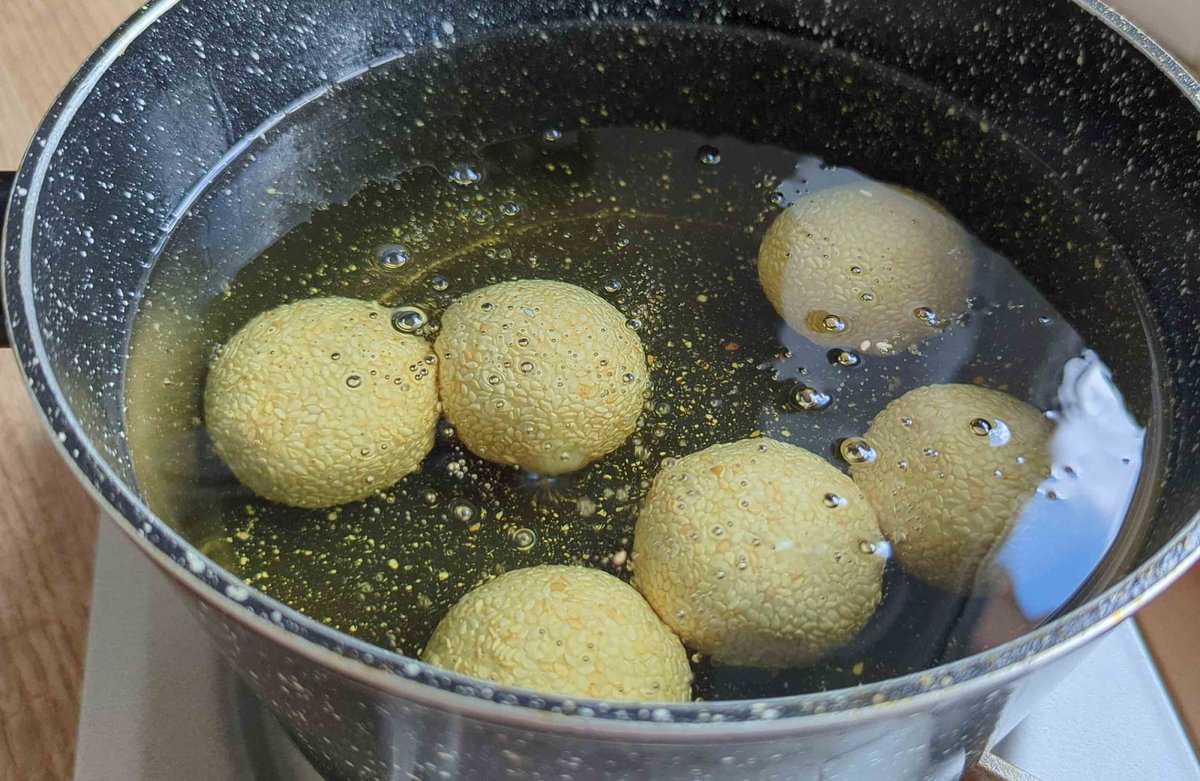
Initially, the balls sink to the bottom. Use a spoon to move them around to prevent sticking. Keep the heat low and fry them slowly.
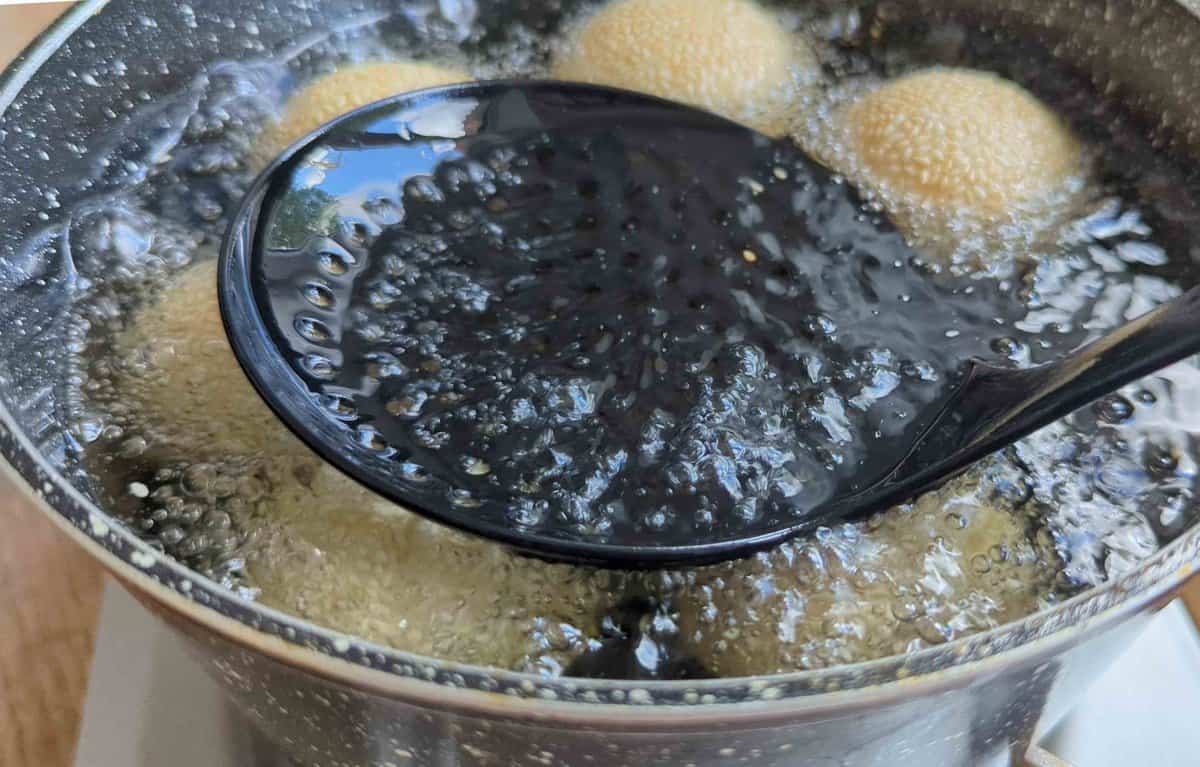
Gradually, they’ll come up to the surface. Press them with a slotted spoon to keep them below the surface at all times. This helps to cook the dough evenly so that the balls expand in all directions uniformly.
Stage 2: Crisp the surface at higher temperature
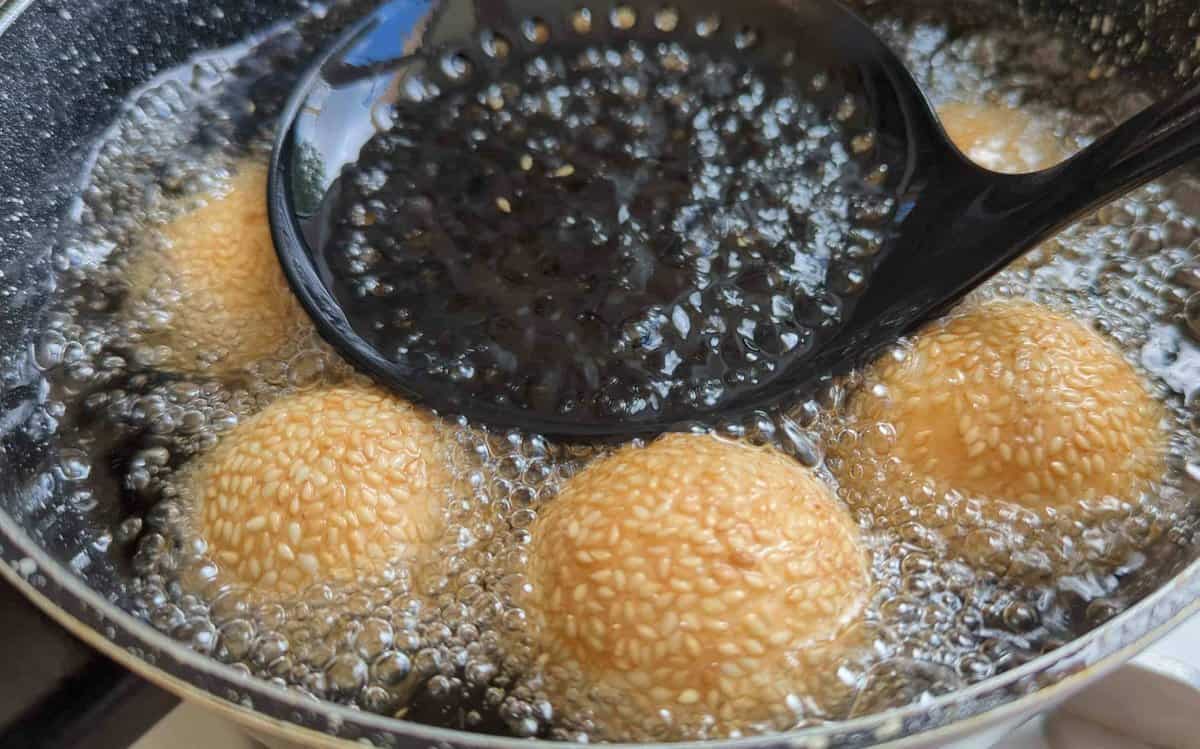
Once the balls have expanded to about 1½ times their original size. Turn the heat up so it increases to about 320°F/160°C. Use this higher temperature to quickly crisp the outer layer of the dough so a strong crust develops which prevents the dough from tearing. Also, this ensures that the balls won’t collapse once cooled.
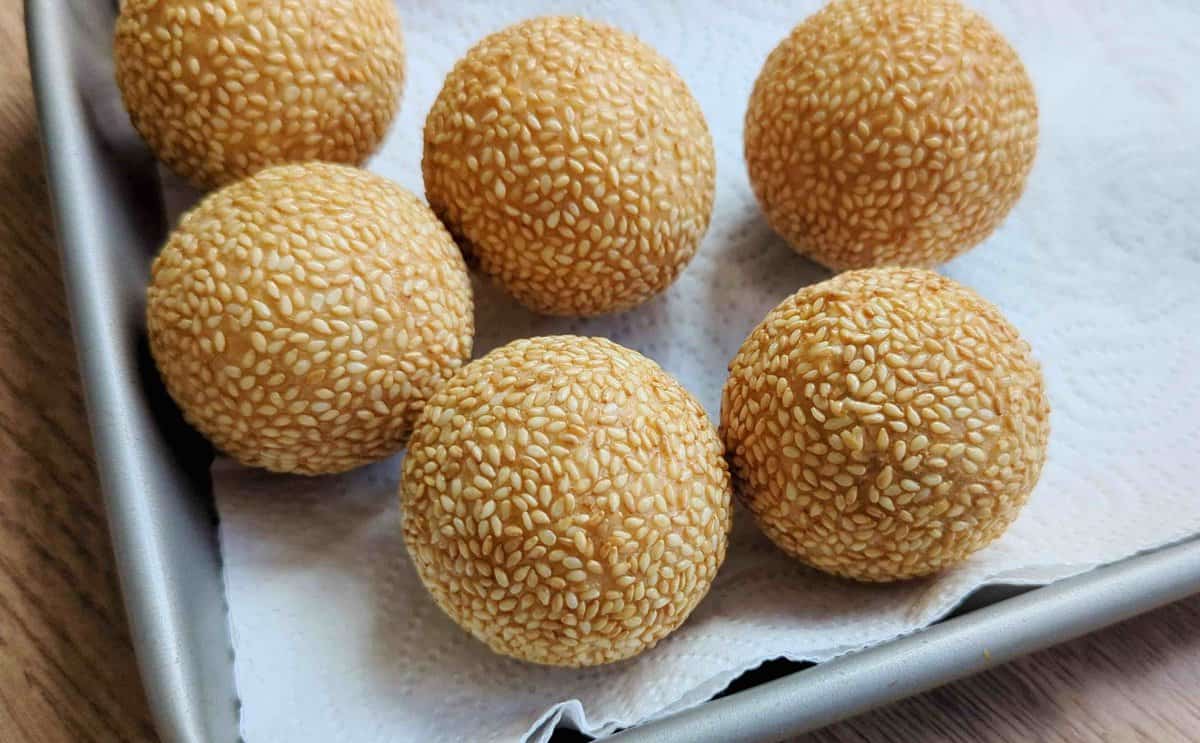
Once the sesame seeds gain a golden color, turn off the heat. With a slotted spoon, transfer the balls to a plate lined with a paper towel to absorb any excess oil.
🛎 TIPS:
- The entire frying process usually takes me 8-10 minutes. The time required may vary depending on the heat power, cookware, the size of the balls, etc.
- Observe closely to see if any ball starts to lose its perfectly round shape and bulges appear. This is a sign that a weak/thin point has developed and the dough may tear if frying continues. Remove the ball in question from the oil immediately.
- If bursting does happen (Rest assured that it won’t happen if you follow the recipe tips attentively), remove the saucepan from the heat immediately and fish out the leaky ball and any filling that has escaped.
Store & reheat
Leave the freshly cooked sesame balls to sit for a few minutes before serving (mind that they’re very hot inside). They taste the best when warm. My children like them at room temperature too.
To store any leftovers, refrigerate them for up to 3 days, or keep them in the freezer for 3 months (inside an airtight container or bag).
To reheat, toast them in an oven preheated at 375°F/190°C for about 8 minutes (defrost first if frozen). Alternatively, reheat them in a preheated air fryer at 375°F/190°C for 3 minutes.
The stored and reheated sesame balls will lose their crispy exterior, but they still taste delicious (the sesame seeds remain crunchy).
Other variations
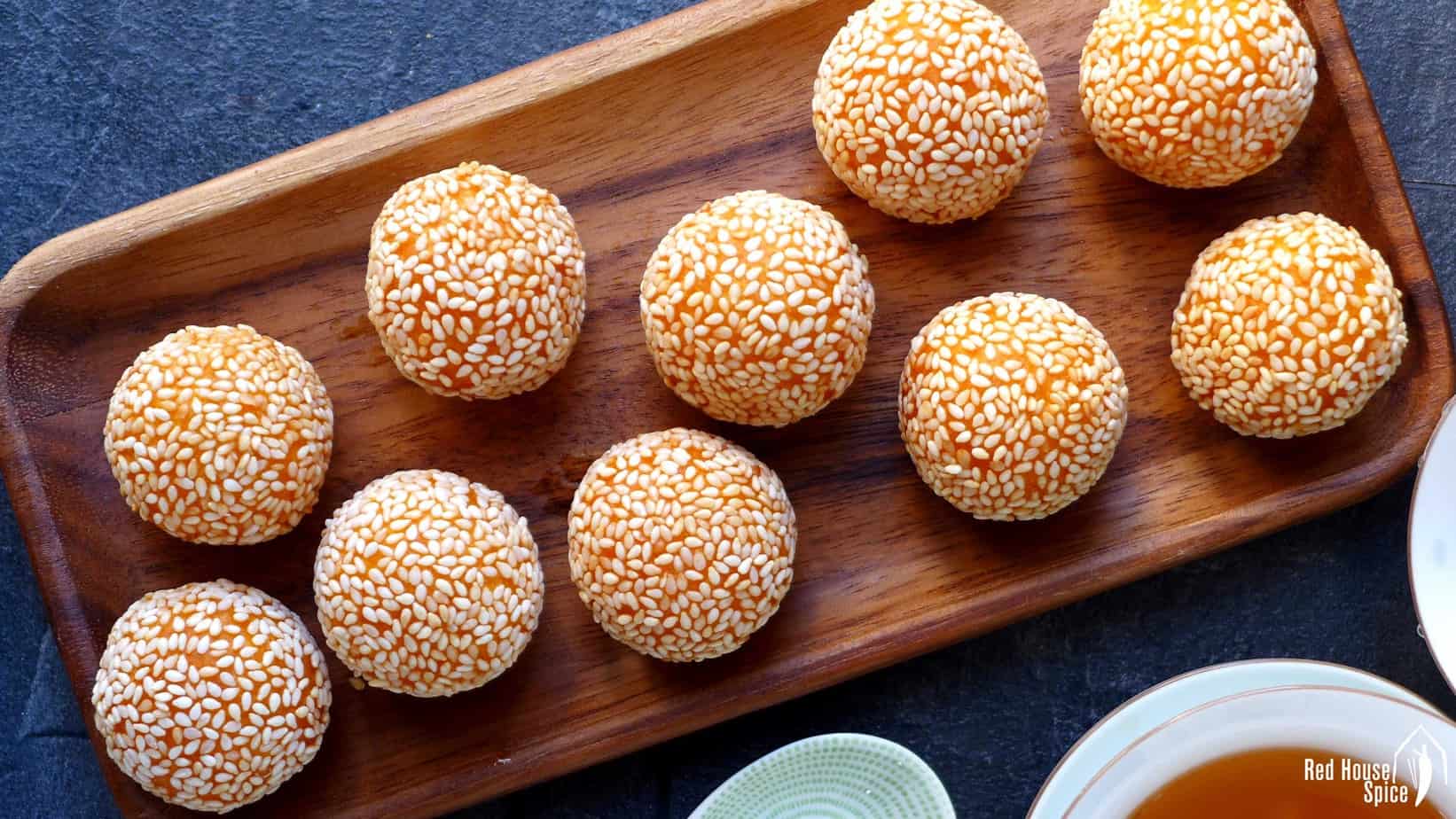
Sweet potato sesame balls are a tasty alternative. They look and taste wonderful, and are very easy to make.
Plain, unstuffed sesame balls are also quite common in China. After deep frying, the balls will become hollow in the middle. Some professional chefs can magically expand the dough to maximum and create a giant “sesame ballon”.
If making plain sesame balls, you may add more sugar to the dough to make them sweeter. In this case, adjust the volume of hot water accordingly.
Recipe FAQs
A: The oven isn’t suitable for this recipe. You could use an air fryer to cook them (spray a layer of oil over) but you won’t be able to achieve the perfectly round shape, crispy crust, or full expansion of the dough.
A: Yes, you can if you are not after the round ball look. Press the assembled balls into flat discs, then pan-fry them with a thin layer of oil until both sides become golden.
A: Absolutely! Sometimes, I use a mixture of white and black sesame seeds. They create a beautiful look.
A: They are gluten-free and can be made vegan by using vegan fillings. You can adapt my recipes for red bean paste and black sesame paste by replacing butter with coconut oil.
A: Theoretically, you can defrost uncooked sesame balls and fry them once they return to room temperature. However, uncooked dough has the potential to crack when frozen, so I don’t recommend doing so.
Other Chinese sweet treats
Looking for more Chinese dessert and snack ideas? Check out these popular recipes:
📋 Recipe
Love this recipe? Please leave a 5-star 🌟🌟🌟🌟🌟 rating in the recipe card below & if you REALLY like it, consider leaving a comment as well!
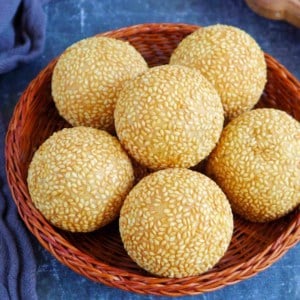
Sesame Balls (Jian Dui/煎堆)
BEFORE YOU START
Ingredients
For the dough
- 2 cup glutinous rice flour - divided
- ¼ cup white sugar
- ⅔ cup hot water - just boiled
- 1 teaspoon neutral cooking oil
For the filling
- ¾ cup red bean paste - or black sesame paste, or lotus paste (see note 1)
You also need
- 1 tablespoon glutinous rice flour
- ⅓ cup sesame seeds - raw or lightly toasted
- Neutral cooking oil - for deep frying (see note 2)
Instructions
Make the dough
- Put about two thirds of the glutinous rice flour into a mixing bowl. Add sugar and mix well. Pour hot water over and mix with chopsticks until a sticky mass forms.
- Add the remaining one third of glutinous rice flour in two batches. Mix with chopsticks, then combine with your hand to form a soft dough that doesn’t stick easily to your hands (see note 3).
- Finally, add oil and knead it into the dough. It will become smoother and completely sticky-free.
Shape the balls
- Roll the dough into a rope then cut it into 12 equal parts. Shape each piece into a ball.
- Divide red bean paste (or the filling of your choice), into 12 equal portions (about 1 tablespoon each). Roll them into balls as well.
- Shape a dough ball into a bowl shape. Place a piece of filling in the middle. Gently push the dough upwards to wrap around the filling tightly. Seal completely at the top, making sure there isn’t any leakage.
Coat the balls
- In a small bowl, mix 1 tablespoon of glutinous rice flour with about ½ cup (120ml) of water. Put sesame seeds into another bowl.
- Briefly roll an assembled ball in the flour-water mixture to wet it all over. Then transfer it to the sesame bowl. Move the bowl in a circular motion so that the ball rolls and gets covered by the seeds.
- Gently press the ball all around to make sure all the seeds stick to the dough securely.
Fry the balls
- Pour oil, enough to fully submerge the sesame balls, into a saucepan/wok for deep-frying. Heat it until it reaches 250°F/120°C.
- Gently slide in the balls. Do not overcrowd them as they will expand. Fry in batches if necessary. Use medium-low heat to fry. Move the balls around with a spoon to prevent sticking.
- Once they start floating on the surface, gently press them down with a slotted spoon so that they are submerged in the oil all the time.
- When the balls expand about 1½ times bigger than their original size, turn the heat up to high so it reaches about 320°F/160°C. Continue frying the balls, while pressing them down, for a short period until the sesame seeds become golden (see note 4).
- Transfer the balls out to a plate lined with a paper towel to absorb any excess oil. Let them sit for a few minutes before serving.
Store & reheat
- You can keep leftovers, inside airtight bags/containers, in the fridge for up to 3 days, or in the freezer for 3 months.
- Reheat them in a preheated oven at 375°F/190°C for about 8 minutes (defrost first if frozen), or in an air fryer preheated at 375°F/190°C for 3 minutes.
Video
NOTES
- The process takes me 8-10 minutes. It may vary depending on your heat power, cookware, and the size of the balls.
- Observe closely to spot any weak/thin spots where the dough might tear if frying continues. Remove the ball in question from the oil immediately.
NUTRITION
NUTRITION DISCLOSURE: Nutritional information on this website is provided as a courtesy to readers. It should be considered estimates. Please use your own brand nutritional values or your preferred nutrition calculator to double check against our estimates.


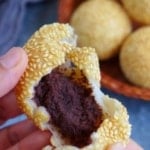

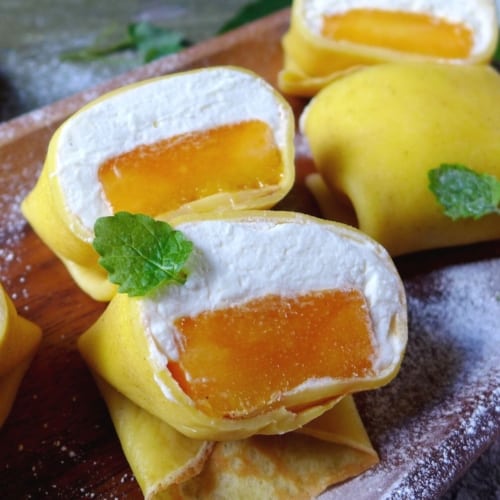
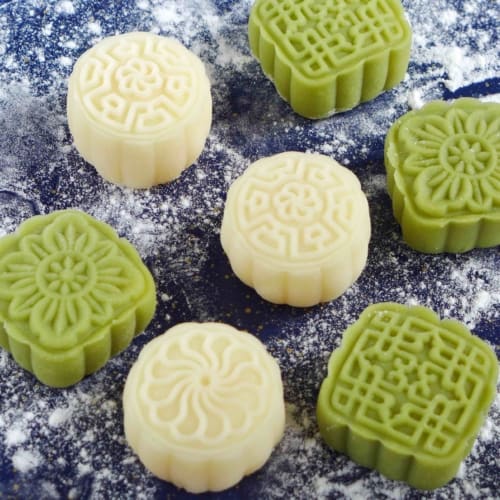
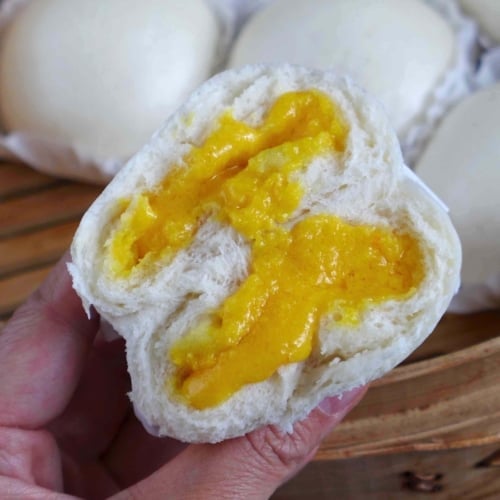
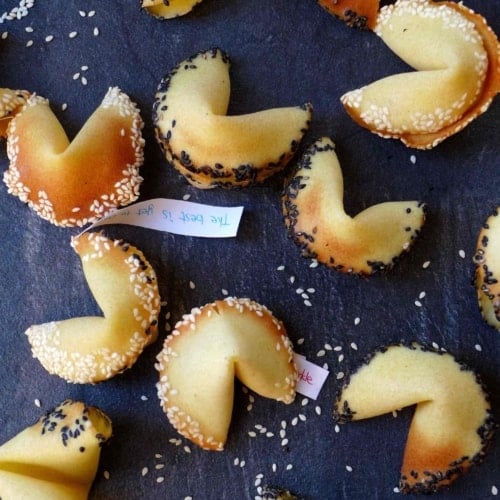

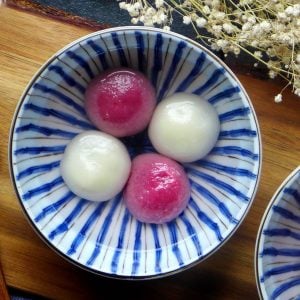
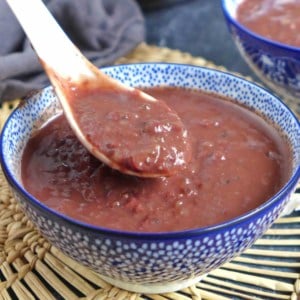
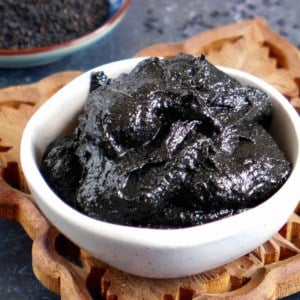
LEAVE A REVIEW